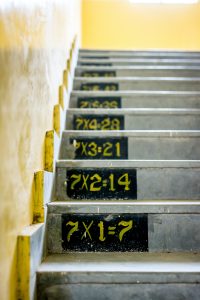
Direct-ED Becomes Carbon Balanced Printer
In January 2022, Direct-ED was officially confirmed as a Carbon Balanced Printer with the World Land Trust. This is amazing news that the team have




Maths is one of those lessons which pops up regularly in everyday life, particularly with regards to the times tables and your ability to work out percentages and fractions based on your knowledge of how numbers are multiplied.
Of course, for kids, this is all mumbo jumbo, and the very idea of the times tables is not only difficult but pretty boring as well. That’s why part of the job of teaching Maths and the times tables is enabling kids to see the subject as more than just a memory game – rather, it is a series of patterns and something which be of huge benefit in life. In this article we will be looking at the importance of the times tables and sharing some of our most popular ideas for bringing these mathematic lessons to life both inside and outside the classroom.
Why we Teach Children Multiplication
There are a few reasons why teaching kids their times tables is such a big part of early learning. For one thing, the times tables feed into division, multiplication, and fraction-based equations – all of which require some understanding of the relationship between different numbers and what it means to multiply single numbers by other single numbers. Traditional times table learning takes single figure multiplication and uses those basic equations to show kids how multiplication between larger numbers works.
Another reason why we teach kids their times tables at an early age is that it helps to develop their memory and mental reasoning, leaving space for more complex equations which use their basic times tables skills. If a child can pull up an answer to a times table question relatively easily and quickly, they will be able to break down longer and more complicated equations more quickly as they progress through the curriculum and start to apply their learning to everyday life.
In terms of future life skills, times tables are crucial and the earlier we can start to apply these lessons to children, the better. But there are certain ways of approaching children’s times tables – with a heavy focus on engagement, interactivity, and a balance of fun and learning.
Ideas for Teaching Kids Times Tables
In order to become engaged with a subject, kids need to be interested in how it works – and one of the best ways of doing this is through games and the application of such skills across their own personal interests. Many subjects do this by bringing in well known characters and storylines, but in maths we find it best to engage kids by turning those numbers into something they want to see and hear about.
For example, if approaching the times table ‘4 x 4’ you can link this to 4 packs of 4 cakes – telling kids that the times tables is the same as ‘4 + 4 + 4 + 4’ and asking them how many cakes you would end up with. This very simply application of the equation makes it easier to visualise by attributing the numbers to something they know and recognise.
Repeated addition is just one way of approaching children’s times tables. Other learning tools you can tap into include the idea that the times tables and multiplication equations are commutative – that is, they are reversible and equate to the same number both ways (e.g., 5 x 6 = 6 x 5); and eventually the concept of division and its link to multiplication (e.g., if 5 x 6 = 30, then 30 divided by 6 = 5). These are lessons that will gradually become more obvious as children progress through the school and the mathematics curriculum, enabling other seemingly more complex equations to in fact become easier using a base knowledge of the times tables.
Without further ado, here are some engaging and interactive ways to bring kids times tables into the classroom.
Find Patterns – There are always patterns to be found in Maths, with the times tables one of those subjects which is full of patterns when you look for them. Start with the 10 times table and show kids that the answer will always end in a 0; likewise, in the 5 times tables the answer always ends in 5 or 0; and in the 2 times tables, the answer is always even.
Engage in Quizzes – Making learning fun can be difficult, but when you engage in regular quizzes which test children’s ability to deal with questions under pressure you are not only testing them on the topic but also helping them get used to an exam / test environment. Try ‘Beat the Clock’ quizzes which add a bit of fun and peril to the game,
Learn in Blocks – Start small and work your way up. Work with parents and set weekly learning goals where kids are encouraged to learn their 2 times table up to 12 x 2 in a week.
Tricks – When all else fails, maths tricks are a great way to give kids a little support. The 9 times table is a great example of a trick that can help kids find the answer – holding all ten fingers in front of you, for the question ‘4 x 9’ put down your fourth finger in the row of 10 fingers. The number of fingers before (3) equates to the tens (30) and the number of fingers after (6) equates to the single digits (6). So, the answer is 36.
Another trick is the use of addition alongside the times tables. For example, if a child is struggling with 7 x 7, the answer can also be found by splitting the multiplication into different parts (e.g., 5 x 7 and then 2 x 7). As the answer to both of these is simpler to work out, adding the two answers together will give you the final 7 x 7 answer.
Have you got your own set of ideas and learning tactics when it comes to teaching kids multiplication? We’d love to hear them!


In January 2022, Direct-ED was officially confirmed as a Carbon Balanced Printer with the World Land Trust. This is amazing news that the team have

If you’re wondering how to home school and are looking for some tips, the first thing to understand is that home learning isn’t just about

Sustainability is the buzzword of the 21st century and seems to have snuck into everything from fashion lines to supermarkets, our favourite television shows and




